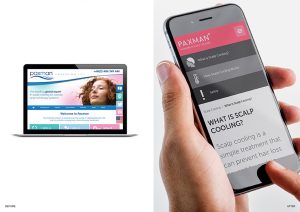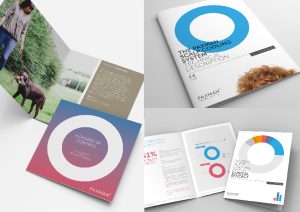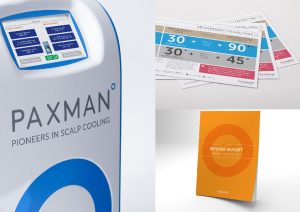Main Content

Embedding effectiveness in design helps cancer patients take back control
A 2019 Design Effectiveness Award winner has been changing the face of cancer across the world – and their new clear brand message has been reaching patients and clinicians thanks to an effective design partnership.
 The Paxman Scalp Cooling System was first developed 20 years ago by the family of Sue Paxman – a mother of four who experienced the trauma of losing her hair through cancer treatment. They found that the damage chemotherapy causes to the hair follicle could be alleviated by reducing the temperature of the head before, during and after the administration of the drugs. They used their existing business knowledge about beer-cooling devices to create a new successful product.
The Paxman Scalp Cooling System was first developed 20 years ago by the family of Sue Paxman – a mother of four who experienced the trauma of losing her hair through cancer treatment. They found that the damage chemotherapy causes to the hair follicle could be alleviated by reducing the temperature of the head before, during and after the administration of the drugs. They used their existing business knowledge about beer-cooling devices to create a new successful product.
They approached The Engine Room for a design strategy that would enable them to compete on a global scale. The results of this partnership speak for themselves: Paxman now have their machines installed in 233 cancer centres in the US and they have overtaken the no.1 competitor within 3 years.
Global turnover has increased from £1.9m in 2015 to £3.5 in 2018. Most importantly, awareness of scalp cooling has increased from an estimated 9% to 25%.
We’ve spoken to Kathryn Daniel, Head of Marketing at Paxman Coolers Ltd, Lesley Gulliver, Managing Director of The Engine Room, and Darren Evans, Design Director at The Engine Room to find out more about their very effective approach.
There were three objectives when you first met: to present a credible brand to investors, to present a more compelling brand than the main competitor in the US, and to increase market awareness of scalp cooling – how did you address those?
Lesley: “The work we did enabled Paxman to move towards all three of these objectives. At the heart of achieving all of them was what we learnt from spending time with the users of the system. All the case studies we met had different stories, but the overall message was the same. For all of them, being given the opportunity to keep their hair allowed them, as a cancer patient, to regain an element of control – when they’re going through a process that’s totally out of their control.”
“That insight was a real breakthrough because one of the main reasons clinician’s were not taking the system seriously was that they saw it as a vanity product. The scalp cooling system had the look and feel of a haircare brand. They weren’t thinking about the wider wellbeing angle. We had to make them realise the process of losing your hair has a massive psychological impact on patients, and preventing it can make a real difference to the overall treatment.”
Darren: “The new identity had to reflect the new clinical look we were going for – calm, ordered, methodical. This fed through to the typography, the language, and the images. Clinicians had to see the product as credible in a scientific field. If they started to believe in it then the chances increased of them recommending it to their patients.”
“And setting them apart from the main competitor was quite simple once we’d got to the core message. People assumed patients wanted to keep their hair to maintain dignity – and no other players in the market were saying anything different. As soon as Paxman offered alternative language around the topic, it put them ahead because it tapped into what patients were really feeling and experiencing. That design insight informed everything. Patients simply wanted to be able to choose who they told about their illness, and how strangers, colleagues, and their children viewed them. Keeping their hair allowed them to be in control of that choice.”
You distilled the message down to three Ps – Personal, Passion and Precision – tell us about how they made a difference to embedding effectiveness…
Darren: “To embed effectiveness we had to understand the culture of Paxman. ‘Personal’ came out of the family story and the personal service that the whole team offers. ‘Passion’ is evident throughout Paxman. They are 100% invested in the product and in the vision for the future. Everyone is passionate about the purpose of the business and they simply will not stop until those needing cancer treatment are offered scalp cooling and it stops hair loss completely for all patients. ‘Precision’ is focusing on the importance of changing the mindset of clinicians and making them realise that this isn’t a beauty product, it is backed by years of scientific research and results. Paxman have a high level of technical knowledge and manufacturing capability.”
How have clients altered their view of the product and the business as a result of working with The Engine Room?
Kathryn: “We needed to up our game and reposition ourselves. We knew we had an effective product, a brilliant team and our work was backed up with 20 years of scientific research and clinical trials – but we weren’t very good at shouting about how great we are. The messaging The Engine Room gave us really helped. They got under our skin and really understood what we were trying to communicate and the psychology behind it all. We had previously just concentrated on aesthetics alone, but they had a very strategic approach to design.”
“The fit of the cap is vital to achieving good results. The Engine Room helped us with putting together instructional videos for users so that they could practice fitting their own cap – giving them another element of control and removing the burden from the healthcare professionals to get that aspect right when they are so time-pressured.”
“They have also been really supportive of developing business training materials for healthcare professionals that they will engage with. Historically, the perceived complexity of this market generally was very off-putting. The documentation still conveys our passionate core messages but providers appreciate the clarity and simplicity of our literature now.”
How has the business shifted as a result of the design input?
 Lesley: “Aside from looking very different, we see a very confident organisation in Paxman now. Today you see them playing to an international stage, head and shoulders above the competition. Internally, the team has used the brand to drive change and have a really good vehicle to move forward, ensuring the communication of the three Ps gets effectively distributed as the team grows.”
Lesley: “Aside from looking very different, we see a very confident organisation in Paxman now. Today you see them playing to an international stage, head and shoulders above the competition. Internally, the team has used the brand to drive change and have a really good vehicle to move forward, ensuring the communication of the three Ps gets effectively distributed as the team grows.”
“Paxman were always a really authentic and lovely team with a great product. Design just facilitated everyone else understanding how great they are.”
The Engine Room’s record at the Design Effectiveness Awards shows that you embed effectiveness into your processes – how much is effectiveness considered when you’re approaching a new project like Paxman’s?
Lesley: “It ranks right at the top of our priorities and starts right at the beginning of our processes with the initial conversation with our client. Impact is really important to us and it’s something we track closely. How can you invest in us if you have nothing to measure us by?”
Darren: “We take the client on a journey to demonstrate to them the value of design and measuring its success. Commitment from the client has to be there to achieve effectiveness. When it works, it really works.”
Looking to the future, what are the next steps for Paxman?
Kathryn: “Awareness is still our biggest hurdle. Patients only have up to half an hour with their oncologist when they receive their diagnosis. There is so much to speak about that and hair loss is never going to be top of that list. But if the patient doesn’t find out about scalp cooling in the very short window before they start treatment, the opportunity to help them might be lost. So we are working a lot on our social media and digital presence so if people search independently to find out more about hair loss they will engage with us.”
Lesley: “After Paxman’s rebrand, competitors have followed suit. This can only be taken as a compliment! But means we have to keep upping our game, alongside Paxman, and put more clear water between them.”
Darren: “We are looking at how we can strategically get them prepared for taking on new international markets and gear them up for further growth. Paxman are involved in every decision. If we didn’t have this strong partnership the outcome wouldn’t be the same. The key to The Engine Room’s success is down to building strong relationships. Through these we achieve long-term goals – we’re not looking for quick wins.”
Image credit:
Oleg at Event Photographer London